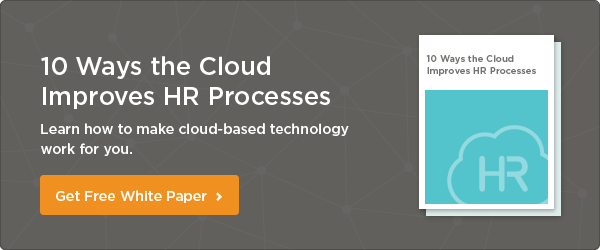

 Cut onboarding time
by 60%—here's the
Ultimate Checklist
that helped do it.
Cut onboarding time
by 60%—here's the
Ultimate Checklist
that helped do it.

Do you know why HR is moving to the cloud? Well, research is showing us that the reasons include the ability to “boost innovation, increase flexibility, and control costs.”
Personally, I agree with that. In the most recent implementations I’ve worked on we experienced greater agility with the solutions. The end result of enhanced access and flexibility for employees and managers was a positive. But one of the primary reasons we were successful was because we understood the need to shift the thinking of all users, including employees, managers, and HR staff.
We approached this in three basic ways.
Start with a Plan
Planning, of course, begins during solution review and selection. During this time the team should identify desired functionality and conduct an assessment, considering things like organizational needs and processes.
In my experiences, as soon as the solution was chosen and implementation dates scheduled, the team began the shift to a SaaS mindset. It was at that stage that we redefined our HR business processes and spent time mapping to our desired state. It gave us the opportunity to make improvements and begin to change thinking and habits—not merely move antiquated legacy processes over to a new technology.
Assess Organizational Readiness
The PwC survey points out, “Organizations need to have a plan to help their employees embrace a SaaS mindset and to work in new ways. Managers and employees need to be engaged up front so that they are part of the process.”
Tweet: Organizations need to have a plan to help their employees embrace a SaaS mindset. @HRCloud
This, I agree, is a critical component. In my implementation experiences, our team consulted with managers early on to gauge their readiness for self-service. We also had conversations with employees to assess their abilities to work in new ways. This allowed us to map out strategies for user adoption, plan for training delivery, and assemble an internal list of FAQs that we anticipated would arise once we rolled out the HR software solution.
In a few instances, due to the work experience and competencies of some employees, we even conducted pre-training sessions covering basic PC and Internet skills in order to ensure employees would be ready to fully use the new HR software.
Communicate (and then communicate some more)
HR professionals who have vetted numerous HRMS solutions understand how the cloud will make our jobs easier and allow for better and more efficient ways of doing business. But other users may not see that… right away. During the ramp up to implementation and during training, remember the most important, and often neglected users of our HR software—the employees. Communicate the changes and new expectations you may have, especially if you’re going to be utilizing employee self service for the first time. Make sure to highlight the benefits of the new cloud-based technology and emphasize how it allows for business continuity whether you’re hit with snowstorms, hurricanes, or any other sort of business interruption.
Promote the ease for employees to access information whether they’re sitting at their desk in the office or in a comfy chair at the local coffee shop. And once you’ve rolled out a new technology it can be easy to stop thinking about it, but regular follow-up with users (employees, managers, new hires) can provide valuable insight.
I found that incorporating these simple steps went a great way towards driving a SaaS mindset across the organization.
HR teams that take the time to plan, assess organizational readiness, and effectively communicate to all end users will readily achieve their planned business/HR goals, realize enhanced efficiencies, and reap the benefits of engaged participation from all users.

Keep Reading
Best HR Software for Universities: 2025 Guide for Higher-Ed HR Leaders
Higher education institutions face unique HR challenges—from managing adjunct faculty
Best HR Tools for Compliance Automation (and Why HR Cloud Leads the Pack)
Top 10 Healthcare HR Challenges That Right HR Platform Can Solve
Healthcare HR teams in 2025 face mounting pressure. A 2025 NSI survey found average
Like What You Hear?
We'd love to chat with you more about how HR Cloud® can support your business's HR needs. Book Your Free Demo

Build a Culture of Recognition. Boost Engagement. Guaranteed.
Workmates empowers employees to stay informed, connected, and appreciated—whether they’re on the front line, in the office, or remote. Recognition drives 12x higher engagement.Trusted by industry leaders in every sector




Cut Onboarding Costs by 60%.
Take the confusion and follow-ups out of onboarding with automated workflows, digital forms, and structured portals—so new hires ramp faster 3X quicker.Trusted by industry leaders in every sector






